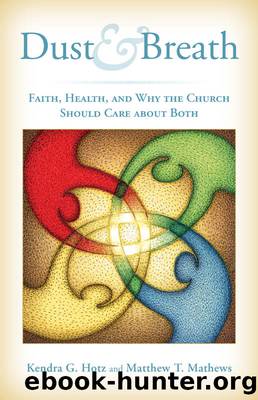Dust and Breath by Hotz Kendra;Mathews Matthew T.;Guderson Gary;

Author:Hotz, Kendra;Mathews, Matthew T.;Guderson, Gary;
Language: eng
Format: epub
Publisher: Eerdmans
Structural Sin at Work: Neighborhood Disadvantage
All the resources we needed, my mother, my grandfather, my grandmother, my father, all got it right here [in the Hill]. I am amazed at that, because now you have to kind of shop around. If you want to turn your dollar over with your people, youâve got to get a list and a map. But [back then] you could stay right here, and never leave it, and get everything you needed, from party-time to church. This is my memories of the Hill, was that families stayed together.
Lois Cain, a resident of the Hill District19
Beyond the stress response, we find other ways in which social circumstances and healthcare are correlated, including what sociologists call neighborhood disadvantage.20 Think back to the food desert. Living in such an environment clearly limits our choices for healthy, fresh food. Living in a neighborhood plagued by gang violence decreases the likelihood that we will take leisurely and healthful walks through our neighborhoods. Relying on inefficient and sometimes expensive public transportation makes what should be a routine trip to the market or doctorâs office a cumbersome and time-consuming half-day journey. Working in low-wage jobs that do not offer health insurance makes it likely that we will not see a doctor for regular health checkups or a dentist for regular cleanings. Sicknesses that might have been avoided with regular health checkups may lead to missed work and make advancement in the workplace more difficult. Decaying teeth will lead to illness and affect our appearance and the way we present ourselves in job interviews. Poorer communities are more likely to be located near environmental hazards and to have older homes that have not been renovated to remove lead-based paint.21 Needing to work multiple jobs to make ends meet leaves us with no leisure time or extra energy to strengthen our communities, to advocate for policy changes, or to court the business development that can revitalize a neighborhood. Poverty, in other words, works in multiple, interlocking ways to compromise our health and leave us vulnerable to disease.
The quotation at the beginning of this section comes from an essay entitled âThe Destruction of Aunt Esterâs House: Faith, Health, and Healing in the African American Community.â It traces out a process that often leads to the destruction of poor but vibrant communities through the displacement of their residents. We see in the process a clear and troubling example of how structural sin works. We see in it that neighborhood disadvantage is no accident and that the poor health that follows is no surprise. Throughout the early twentieth century, racist attitudes and policies resulted in racially segregated neighborhoods. In spite of the segregation, within such neighborhoods a deep sense of community might develop and thrive. As the resident of the Hill explained, you could find in such a neighborhood everything you needed: family and friends, business and churches, recreation and work. Churches, community centers, and local businesses, together with residents who were invested in their neighborhoods, would work together to build a strong community.
Download
This site does not store any files on its server. We only index and link to content provided by other sites. Please contact the content providers to delete copyright contents if any and email us, we'll remove relevant links or contents immediately.
Joan of Arc by Mary Gordon(3271)
Victory over the Darkness by Neil T. Anderson(2392)
The Gnostic Gospels by Pagels Elaine(2035)
Devil, The by Almond Philip C(1907)
The Nativity by Geza Vermes(1854)
The Psychedelic Gospels: The Secret History of Hallucinogens in Christianity by Jerry B. Brown(1830)
Going Clear by Lawrence Wright(1577)
Going Clear: Scientology, Hollywood, and the Prison of Belief by Lawrence Wright(1576)
Barking to the Choir by Gregory Boyle(1509)
A TIME TO KEEP SILENCE by Patrick Leigh Fermor(1501)
Old Testament History by John H. Sailhamer(1499)
Augustine: Conversions to Confessions by Robin Lane Fox(1476)
A History of the Franks by Gregory of Tours(1402)
The Knights Templar by Sean Martin(1399)
A Prophet with Honor by William C. Martin(1378)
The Bible Doesn't Say That by Dr. Joel M. Hoffman(1374)
by Christianity & Islam(1351)
The Amish by Steven M. Nolt(1254)
The Time Traveler's Guide to Medieval England by Ian Mortimer(1219)
